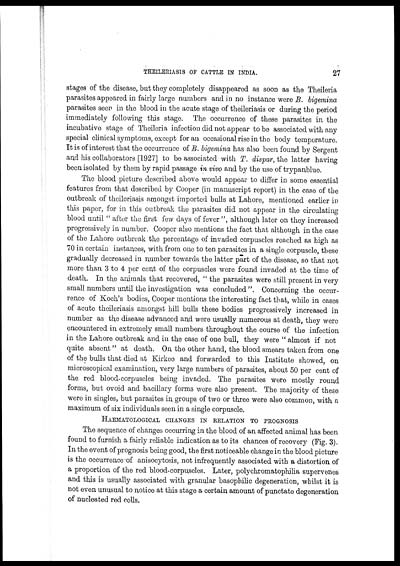Medicine - Veterinary > Veterinary colleges and laboratories > Indian journal of veterinary science and animal husbandry > Volume 7, 1937 > Original articles > Theileriasis of cattle in India
(47) Page 27
Download files
Individual page:
Thumbnail gallery: Grid view | List view

THEILERIASIS OF CATTLE IN INDIA. 27
stages of the disease, but they completely disappeared as soon as the Theileria
parasites appeared in fairly large numbers and in no instance were B. bigemina
parasites seen in the blood in the acute stage of theileriasis or during the period
immediately following this stage. The occurrence of these parasites in the
incubative stage of Theileria infection did not appear to be associated with any
special clinical symptoms, except for an occasional rise in the body temperature.
It is of interest that the occurrence of B. bigemina has also been, found by Sergent
and his collaborators [1927] to be associated with T. dispar, the latter having
been isolated by them by rapid passage in vivo and by the use of trypanblue.
The blood picture described above would appear to differ in some essential
features from that described by Cooper (in manuscript report) in the case of the
outbreak of theileriasis amongst imported bulls at Lahore, mentioned earlier in
this paper, for in this outbreak the parasites did not appear in the circulating
blood until " after the first few days of fever ", although later on they increased
progressively in number. Cooper also mentions the fact that although in the case
of the Lahore outbreak the percentage of invaded corpuscles reached as high as
70 in. certain instances, with from one to ten parasites in a single corpuscle, these
gradually decreased in number towards the latter part of the disease, so that not
more than 3 to 4 per cent of the corpuscles were found invaded at the time of
death. In the animals that recovered, " the parasites were still present in very
small numbers until the investigation was concluded ". Concerning the occur-
rence of Koch's bodies, Cooper mentions the interesting fact that, while in cases
of acute theileriasis amongst hill bulls these bodies progressively increased in
number as the disease advanced and were usually numerous at death, they were
encountered in extremely small numbers throughout the course of the infection
in the Lahore outbreak and in the case of one bull, they were " almost if not
quite absent" at death. On the other hand, the blood smears taken from one
of the bulls that died at Kirkee and forwarded to this Institute showed, on
microscopical examination, very large numbers of parasites, about 50 per cent of
the red blood-corpuscles being invaded. The parasites were mostly round
forms, but ovoid and bacillary forms were also present. The majority of these
were in singles, but parasites in groups of two or three were also common, with a
maximum of six individuals seen in a single corpuscle.
HAEMATOLOGICAL CHANGES IN RELATION TO PROGNOSIS
The sequence of changes occurring in the blood of an affected animal has been
found to furnish a fairly reliable indication as to its chances of recovery (Fig. 3).
In the event of prognosis being good, the first noticeable change in the blood picture
is the occurrence of anisocytosis, not infrequently associated with a distortion of
a proportion of the red blood-corpuscles. Later, polychromatophilia supervenes
and this is usually associated with granular basophilic degeneration, whilst it is
not even unusual to notice at this stage a certain amount of punctate degeneration
of nucleated red cells.
Set display mode to: Large image | Zoom image | Transcription
Images and transcriptions on this page, including medium image downloads, may be used under the Creative Commons Attribution 4.0 International Licence unless otherwise stated. ![]()
| Permanent URL | https://digital.nls.uk/75239222 |
|---|
| Description | Covers articles from 1937. |
|---|---|




